




 Coniston Water
Coniston Waterplacename:- station, Coniston, West 2
 goto source
goto sourcePage 49:- "STATION II. When you are opposite to the peninsula last described proceed through a gate on the left hand, and from the rocky eminence you have a general view of the lake, both ways. To the south, a sweet bay is formed between the horns of two peninsulas, and beyond that a fine sheet of water appears, terminated by the promontories which form the straits, through which the lake has its outlet. From thence the coast is beautifully diversified by a number of green eminences crowned with wood, and sequestered cottages interspersed among them half concealed by yew trees; and, above them, a wave of rocky, spiral mountains, dressed in brown vegetation, form the most romantic scenes. Between this and a wooded eminence, a green hill, cut into inclosures to"
 goto source
goto sourcePage 50:- "the very top, in some parts patched with rock and little groves, has a beautiful appearance; especially when contrasted with the barren scenes on one hand, and the deep shade of a waving wood on the other. At the foot of this cultivated tract, and on the margin of the lake, a few white houses, partly concealed by a grove, look like enchanted seats on a fairy ground. Behind these a barren bleak mountain frowns in sullen majesty, and down his furrowed side the Black-beck of Torver rolls its fretted torrent. Just at your feet lies the oblong rocky isle of Peel; and near it the dark points of half-immersed rocks just show themselves by turns. Here is the finest picture of the lake, and when it is smooth the whole is seen reflected on the shining surface of the watery mirror. On the western side the coast is steep rocks. The eastern side is much embayed. The high end of the lake is here in view, yet it seems to wind both ways behind the opposite promontories. The range of naked rocks that cross the head of the lake appear now awful, from their sable hue, and behind them, the immense mass of Cove, Rydal-head, and many nameless mountains, have a most stupendous appearance, and seeming inaccessible height. A succession of pretty bays open to the traveller as he advances; the banks become more wooded,"
 goto source
goto sourcePage 51:- "and more cultivation appears. On the western margin stands the lady of the lake, Coniston-hall, concealed in a grove of tall trees, and above it, the village of the same name. The hall has only changed masters twice since the conquest, and has belonged to the family of Fleming most of time."

CTESD29V.jpg
"West's 2d. Station"
square symbol
item:- JandMN : 182.5
Image © see bottom of page
placename:- station, Coniston, West 2
"West's 2d. Station"
level with Peel Island.

Click to enlarge
BTJ53.jpg From north shore of Peel Ness,
(taken 13.8.2010)

Click to enlarge
BTJ54.jpg From west shore of Peel Ness,
(taken 13.8.2010)

Click to enlarge
BTJ55.jpg From a rocky eminence, south end of Peel Ness,
(taken 13.8.2010)

Click to enlarge
BTJ56.jpg From the shore below the rocky eminence, south end of Peel Ness,
(taken 13.8.2010)

Click to enlarge
BTJ57.jpg (taken 13.8.2010)

Click to enlarge
BTJ58.jpg (taken 13.8.2010)
: West, Thomas
